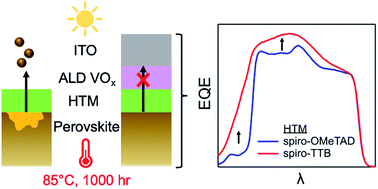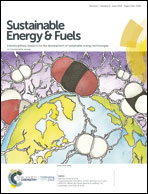Atomic layer deposition of vanadium oxide to reduce parasitic absorption and improve stability in n–i–p perovskite solar cells for tandems†
Abstract
Two critical issues associated with semi-transparent, n–i–p perovskite solar cells for 2-terminal tandem devices are parasitic absorption and long-term instability associated with the widely used spiro-OMeTAD and MoOx hole transport and buffer layers, respectively. In this work, we present an alternative hole contact bilayer that consists of a 30 nm undoped layer of spiro-TTB in conjunction with 9 nm of air-stable vanadium oxide (VOx) deposited via atomic layer deposition. The low absorption of UV and visible light in this bilayer results in the fabrication of a semi-transparent perovskite cell with 18.9 mA cm−2 of photocurrent, a 14% increase compared to the 16.6 mA cm−2 generated in a control device with 150 nm of doped spiro-OMeTAD. The ALD VOx buffer layer shows promise as a stable alternative to MoOx; an unencapsulated Cs0.17FA0.83Pb(Br0.17I0.83)3 device with ALD VOx and ITO as the top contact maintains its efficiency following 1000 hours at 85 °C in a N2 environment. Lastly, we use transfer matrix modeling of the optimized perovskite stack to predict its optical performance in a monolithic tandem cell with heterojunction silicon.



 Please wait while we load your content...
Please wait while we load your content...
